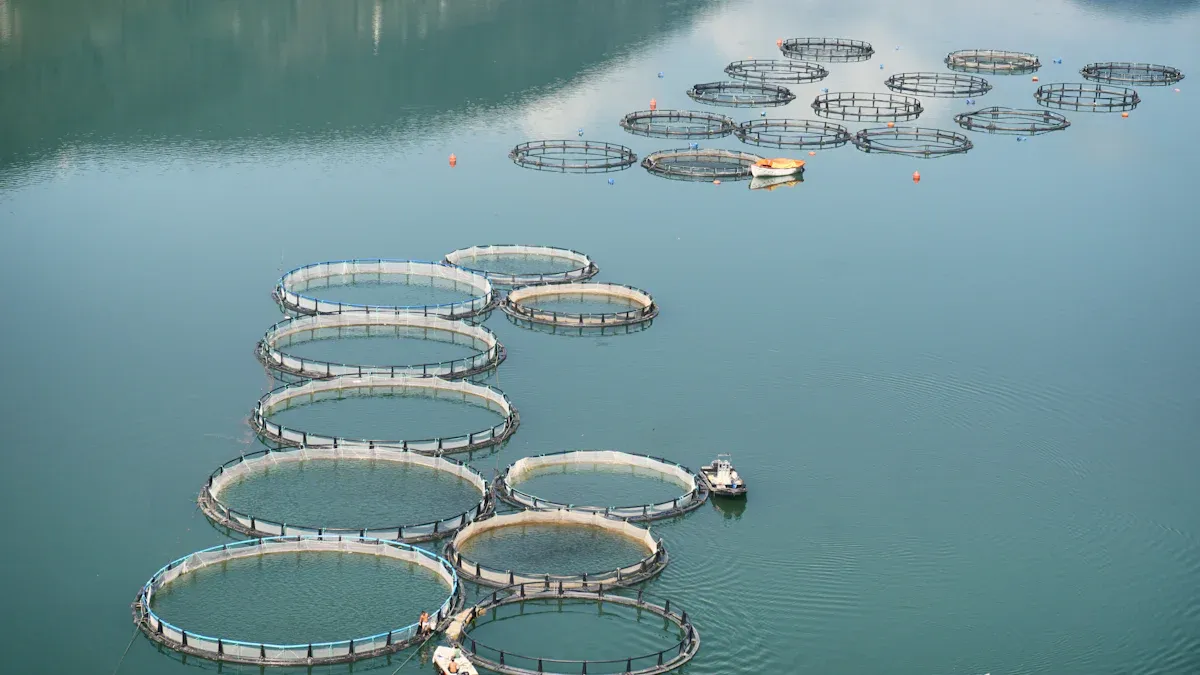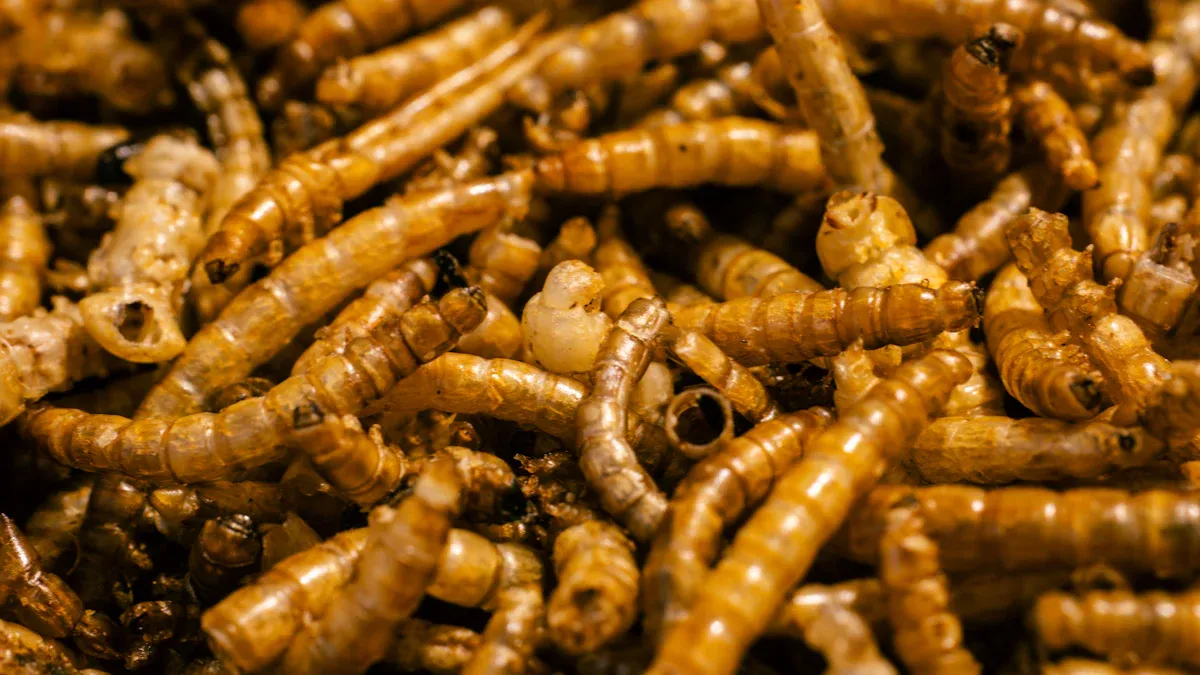
Aquaculture faces a big challenge: sustainability. Overfishing and resource depletion strain ecosystems. Mealworms for Aquaculture offer a game-changing solution. Packed with nutrients, they replace traditional fishmeal. Plus, mealworm farming is eco-friendly. A reliable mealworm supplier can help producers meet growing demand while reducing environmental impact. Could this be the future of fish feed?
Key Takeaways
- Mealworms are an eco-friendly option instead of regular fish food. They have lots of protein and nutrients to help fish grow.
- Adding mealworms to fish feed makes fish healthier. It helps their stomachs work better and boosts their immune system.
- Growing mealworms is better for the planet. It uses farm waste, cuts down pollution, and supports recycling ideas.
Nutritional Benefits of Mealworms for Aquaculture
High Protein and Amino Acid Content
Mealworms are a powerhouse of nutrition. They contain between 47% and 60% crude protein on a dry matter basis, making them an excellent protein source for aquaculture. This high protein content supports the growth and development of aquatic species like trout and tilapia. Additionally, mealworms are rich in polyunsaturated fatty acids (PUFAs), which are essential for maintaining healthy fish. However, they do have some amino acid deficiencies, such as methionine, which can be supplemented in feed formulations to meet specific dietary needs.
Studies also show that mealworms raised on nutrient-rich diets can further enhance their protein levels. For example, mealworms fed wheat bran demonstrated significantly higher protein content, making them even more valuable for aquaculture.
Comparison with Traditional Fishmeal
How do mealworms stack up against traditional fishmeal? Quite well, actually. While fishmeal has been the go-to protein source for years, mealworms offer a sustainable alternative with comparable nutritional benefits. Here’s a quick comparison:
| Nutrient | Mealworms (per 100g DM) | Fishmeal (per 100g DM) |
|---|---|---|
| Crude Protein | 47-60% | Varies |
| Crude Fats | 31-43% | Varies |
| Amino Acid Profile | Deficient in methionine, lysine; rich in valine, tyrosine | Balanced |
Mealworms also have a lower ash content, which can reduce waste in aquaculture systems. However, their high moisture content requires careful handling and storage.
Essential Nutrients for Aquatic Species
Mealworms provide a range of essential nutrients that benefit aquatic species. They are packed with vitamins like B12, B3, and E, as well as minerals such as copper, zinc, and phosphorus. These nutrients play a crucial role in fish growth, immunity, and overall health.
Research highlights that mealworm-based diets can enhance digestive enzyme activity in fish. For instance, Nile tilapia fed mealworm diets showed increased protease activity, while rainbow trout experienced improved gut health and nutrient absorption. The presence of chitin in mealworms also promotes a healthier gut microbiota, which can boost immunity and reduce disease risks.
Mealworms for Aquaculture are not just a protein source—they’re a complete nutritional package that supports the well-being of aquatic species.
Practical Applications of Mealworms in Aquaculture
Enhancing Fish Growth and Health
Mealworms have proven to be a valuable addition to aquaculture feed, significantly boosting fish growth and overall health. Studies show that replacing up to 25% of traditional fishmeal with mealworm meal leads to positive growth performance in species like rainbow trout, tilapia, and European sea bass. For example, guppies fed a fermented mealworm diet grew faster and displayed healthier gut microbiota. This improvement in growth rates stems from the high-quality protein and essential nutrients mealworms provide.
Additionally, mealworms offer a sustainable alternative to fishmeal without compromising fish health. Their inclusion in feed formulations enhances nutrient utilization, ensuring fish grow efficiently while maintaining robust health. Farmers can rely on mealworms to support the development of strong, healthy aquatic species.
Improving Gut Microbiota and Immunity
Mealworms do more than just promote growth—they also improve gut health and immunity in aquatic species. The chitin in mealworm exoskeletons plays a key role in modifying gut microbiota, encouraging the growth of beneficial bacteria. For instance, Atlantic salmon fed mealworm-based diets experienced a healthier gut microbiota composition, which boosted their digestion and immunity.
Fermented mealworms take this a step further. The fermentation process introduces probiotics that enhance gut health and nutrient absorption. Guppies on a fermented mealworm diet showed a gut microbiota dominated by Proteobacteria, linked to better digestion and stronger immunity. This makes mealworms an excellent choice for aquaculture operations aiming to improve fish resilience against diseases.
Versatility in Feed Formulations
Mealworms for Aquaculture are incredibly versatile, fitting seamlessly into various feed formulations. Feeding trials on species like Nile tilapia, rainbow trout, and gilthead sea bream demonstrate that mealworm meal can replace fishmeal at inclusion rates of up to 70% without affecting growth performance. This flexibility allows producers to tailor feed formulations to meet the specific needs of different species.
Moreover, mealworms can be reared on agricultural by-products, turning waste into a valuable resource. This not only reduces dependency on wild fish stocks but also supports sustainable farming practices. Whether used in pelletized feed or fermented diets, mealworms offer a practical and eco-friendly solution for aquaculture.
Environmental and Economic Advantages of Mealworms

Reducing Overfishing and Resource Depletion
Overfishing has pushed many marine species to the brink, and traditional fishmeal production only adds to the problem. Mealworms offer a sustainable alternative that helps reduce this pressure on marine ecosystems. By replacing fishmeal with mealworms, aquaculture producers can significantly cut their reliance on overfished marine resources.
Studies back this up. For instance:
| Study Title | Findings | Environmental Impact |
|---|---|---|
| Fishmeal replacement by mealworm in diet of farmed Pacific white shrimp | Mealworms enhance growth performance and immune response in shrimp | Reduces reliance on fishmeal, mitigating overfishing and resource depletion |
| Mealworm: Potential and Challenges to Promote Circular Economy | Mealworms can replace fishmeal in aquaculture with positive effects on various fish species | Supports sustainability in aquaculture, reducing fishmeal demand and overfishing |
These findings highlight how mealworms can help protect marine biodiversity while supporting the growing demand for aquaculture feed.
Lowering Carbon Footprint and Waste
Mealworms are not just good for the oceans—they’re also great for the planet. Traditional fishmeal production has a high carbon footprint due to fishing, processing, and transportation. In contrast, mealworms can be farmed locally using agricultural by-products, which reduces emissions and minimizes waste.
Mealworm farming also promotes a circular economy. By turning organic waste into high-quality protein, mealworms help close the loop on resource use. This makes them an eco-friendly choice for aquaculture producers looking to lower their environmental impact.
Cost-Effectiveness for Aquaculture Producers
Switching to mealworms isn’t just about saving the planet—it’s also about saving money. Mealworms can be produced at a lower cost compared to fishmeal, especially when reared on inexpensive agricultural waste. This cost-effectiveness makes them an attractive option for aquaculture producers.
Additionally, mealworms’ high nutritional value means less feed is needed to achieve the same growth performance in fish. This reduces overall feed costs while maintaining healthy and productive aquaculture systems. Mealworms for Aquaculture are proving to be a win-win solution for both the environment and the economy.
The Future of Mealworms for Aquaculture by 2025
Innovations in Mealworm Farming Technology
Advancements in mealworm farming technology are paving the way for more efficient and sustainable aquaculture practices. Automated farming systems now streamline the rearing process, reducing labor costs and improving productivity. Innovations like climate-controlled facilities and AI-driven monitoring systems ensure optimal conditions for mealworm growth. These technologies not only enhance yield but also maintain consistent quality, which is crucial for aquaculture feed.
Researchers are also exploring genetic improvements to boost mealworm nutritional content. By optimizing their protein and fat levels, mealworms can better meet the dietary needs of aquatic species. These breakthroughs make mealworms an even more attractive option for aquaculture producers.
Scaling Production to Meet Global Demand
The demand for sustainable protein sources is skyrocketing, and mealworms are stepping up to the challenge. The mealworm market is projected to grow at a compound annual growth rate (CAGR) of 7.4% from 2024 to 2031. This growth reflects the increasing recognition of their nutritional benefits, such as high protein and fat content, which support fish growth and health.
To meet this demand, large-scale mealworm farms are being established worldwide. These facilities use innovative farming techniques to produce mealworms efficiently and at scale. By expanding production capacity, the industry ensures a steady supply of mealworms for aquaculture, helping to reduce reliance on traditional fishmeal.
Integration into Circular Economy Models
Mealworms are a perfect fit for circular economy models. They can transform organic waste into high-quality feed, reducing waste while creating valuable products. For example, agricultural by-products like wheat bran can serve as mealworm feed, turning waste into a resource.
Their versatility extends beyond aquaculture. Mealworms contribute to industries like agriculture, food production, and even pharmaceuticals. By integrating mealworm farming into circular systems, producers can support sustainable food systems and reduce environmental impact. Mealworms for Aquaculture exemplify how innovative solutions can drive both sustainability and profitability.
Mealworms for Aquaculture are reshaping the industry with their impressive benefits. Packed with protein and fat, they boost fish growth and gut health. Their ability to recycle organic waste aligns perfectly with sustainable practices. By replacing fishmeal, they reduce environmental strain and support a circular economy. Continued research and innovation will unlock even more potential, making mealworms a cornerstone of aquaculture’s future.
FAQ
What makes mealworms a sustainable choice for aquaculture?
Mealworms consume agricultural by-products, reducing waste. They require less water, land, and energy compared to traditional protein sources, making them an eco-friendly option for fish feed. 🌱
Can mealworms fully replace fishmeal in aquaculture diets?
Mealworms can replace up to 70% of fishmeal in many species’ diets without affecting growth. However, specific formulations may require supplementation for optimal nutrition.
Are mealworms safe for fish and the environment?
Yes! Mealworms are safe for fish and promote gut health. Their farming process minimizes environmental harm, supporting sustainable aquaculture practices.


